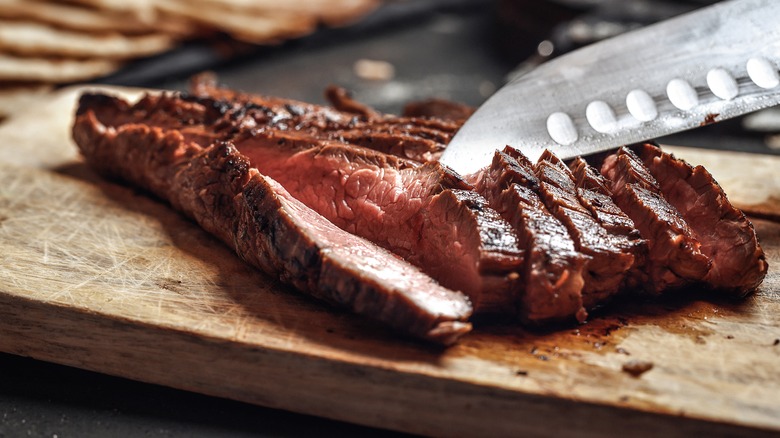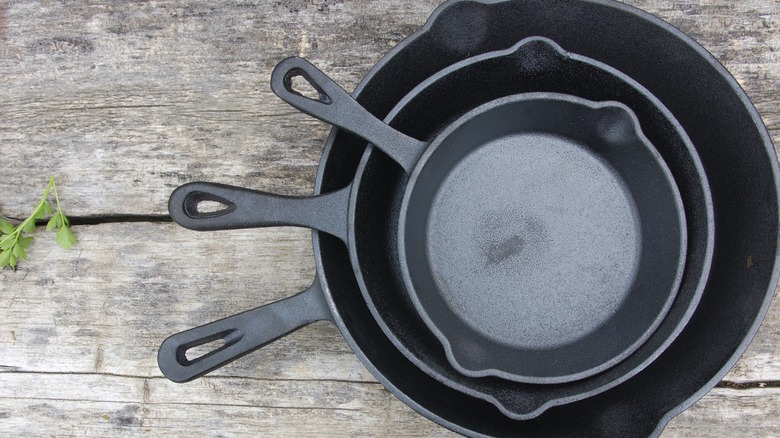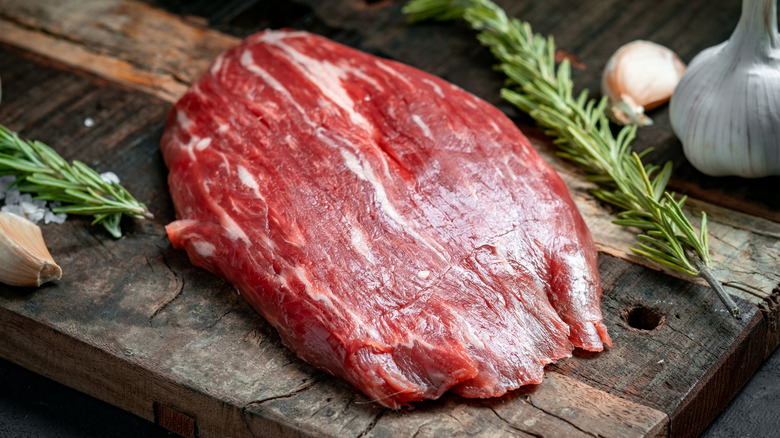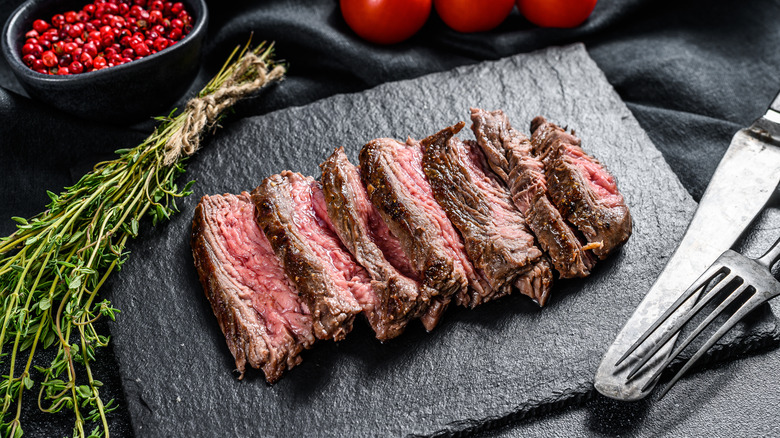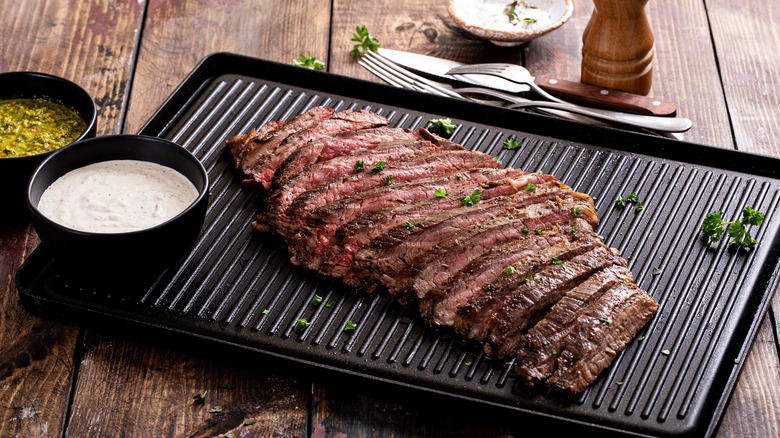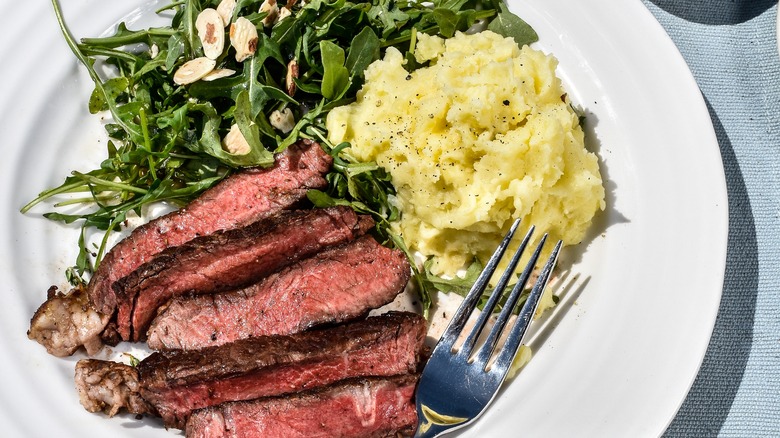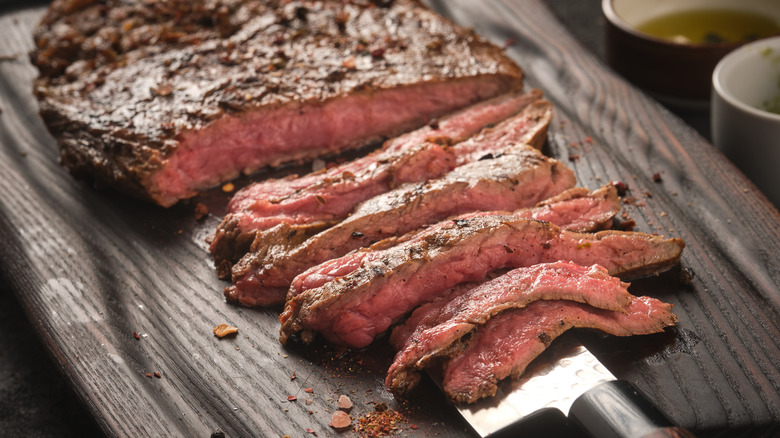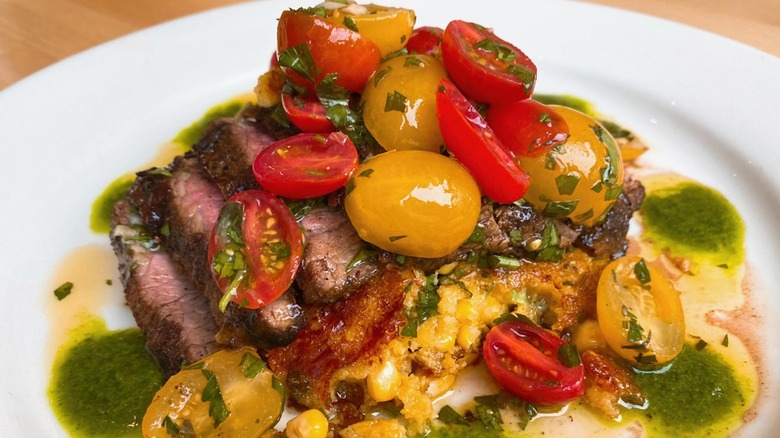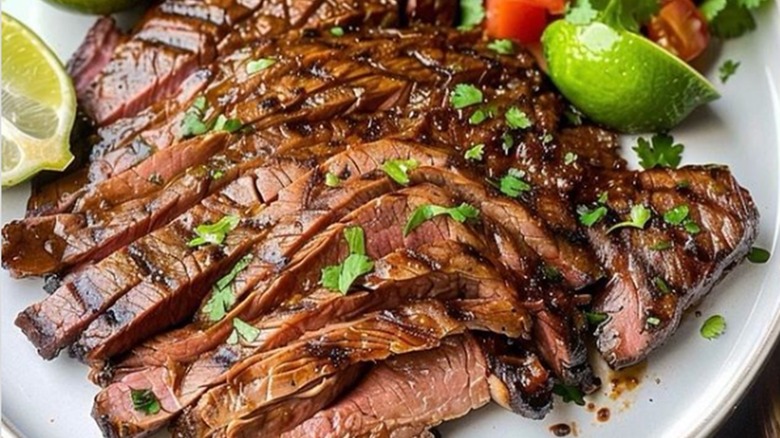9 Chef-Approved Tips That Will Take Your Flank Steak To The Next Level
If you're looking for an affordable cut of beef that's high in protein and low in fat, you'll want to consider flank steak. It's a lean, boneless cut taken from the cow's abdominal muscles, also known as the flank. Sometimes referred to as jiffy steak, beef flank, and plank steak, it is incredibly versatile, with a big, beefy flavor. It's the perfect choice to grill and enjoy as the star of your meal, and you can also use it in dishes like fajitas, salads, or pad see ew. See what we mean by versatile?
To help you up your flank steak game, we spoke with three experts: Lisa Schroeder, Executive Chef and Owner of Mother's Bistro & Bar in Portland, Oregon; Marcelo Mintz, a chef with over two decades of experience from Kutztown, Pennsylvania; and Bryan Koppana, Executive Chef and Owner of Moonlight Meadows in Ishpeming, Michigan. Read on to discover nine tips that will help take your flank steak to the next level.
1. You don't need fancy cooking equipment
Before you head to the store for new equipment, know that you probably already have everything you need to cook a great flank steak. All of our experts recommend preparing flank steak on a grill. Both charcoal and gas grills will give you great flavor, but if you don't have access to an outdoor grill, all is not lost. You can still use a heavy non-stick skillet or a grill/griddle combination that sits on your stovetop burners.
Flank steak can also be cooked in the oven — you can either bake or broil it in an oven-safe dish or pan. Of course, if you have a smoker or prefer sous vide, you can cook flank steak with those methods, too. Whether you enjoy grilling, baking, broiling, smoking, or sous vide cooking, you can enjoy a great flank steak dinner. A few other simple tools that will help the process are a reliable meat or instant-read thermometer, tongs, a cutting board, and a sharp knife to slice your steaks.
2. Look for flank steaks with thin, even marbling
You can pick up a flank steak at most butcher shops and grocery stores. A whole flank steak weighs about 1 to 2 pounds, and it will be around ¾- to 1-inch thick. Mintz recommends choosing a flank steak with the most fat marbling in between the long fibers of meat. Flank steaks are naturally lean, but those small white lines of intramuscular fat found within red meat help retain moisture and flavor during the cooking process.
Choosing a steak with thin, even marbling will help lock in the flavor and prevent it from drying out. If your flank steak comes with a small white fat cap near one end or small stretches of fat that pull away from the raw beef, feel free to trim those off before cooking for the leanest experience. But don't skip out on the marbling as it translates to tenderness.
3. You don't need to marinate flank steaks, but it can enhance the flavor
Do you need to marinate your flank steak? Not necessarily, according to Koppana who says, "A marinade can add a ton of flavor, but just salt and pepper on a charcoal grill is really great."
If time isn't an issue, Schroeder is a proponent of it and explains, "Marinating the flank steak is key — it helps infuse flavor and tenderize the meat." She prefers marinating flank steaks in the fridge for at least three hours, if not overnight. According to some advice, the best method is to place your steak in a bowl or resealable bag and add enough marinade to cover it completely. When you're ready to cook, remove the steaks from the fridge and the extra marinade and let the meat come to room temperature.
Ultimately, your decision to marinate will come down to the flavor you like and the dish you're preparing. If you want it to showcase the flank steak's natural beefy flavor, then feel free to skip that step. If you're hoping to tenderize the steak and add extra flavors to elevate your dish, then you may want to consider a marinade.
4. Grilling is a fast and flavorful way to cook flank steaks
With all the different ways you can cook flank steak, you may wonder which technique offers the best flavor in the shortest amount of time. Our experts all say that grilling is ideal for flank steaks. Because they're relatively thin, the steaks will cook quickly, so you don't need to spend that much time at the grill. Plus, grilling will allow you to get a nice char and lock in that bold, beefy flavor.
Mintz says that putting your steak in a pressure cooker might result in a slightly faster cook time, but he still recommends grilling for a fast and flavorful meal. "Another way to speed up cooking is to slice the meat into bite-size strips and stir-fry instead of grilling," says Schroeder. If you're trying to get dinner on the table quickly, a stir-fry is another fast option for cooking your flank steak.
5. Grill the steaks at a high heat — but not for too long
When you're ready to grill, pat your steaks dry with a paper towel to remove any excess moisture or marinade. Do you need to allow your steak to come to room temperature before cooking? Not necessarily. While some chefs swear by that technique, others find it unnecessary. If you choose to let your steak come to room temperature first, just make sure you're not letting it sit out for too long. The USDA warns that perishable foods shouldn't be left at room temperature for more than two hours.
Flank steak does well cooked quickly at a high heat, making it a great choice for grilling, broiling, and pan-searing. When it comes to grilling, Mintz says it's important to preheat your grill first. Make sure it's at a high heat around 450 F before adding your steaks and grilling for three to five minutes per side. Also, he recommends only moving your steaks to flip or turn them 90 degrees if you want your meat to have grill marks. Otherwise, avoid moving them too much — it could prevent the steaks from getting a proper sear.
6. Don't overcook it — aim for medium rare
Our experts all agree that flank steak is best enjoyed medium rare. "Don't ever push it past medium rare. You might regret it," cautions Koppana. Remember, flank steak is thin and lean, so it doesn't take much to overcook it.
The easiest way to know when your steak is ready to come off the grill is by checking the temperature. Insert a meat thermometer or instant-read thermometer through the side of the steak so that the tip reaches the center. Medium-rare steaks will measure between 130 and 135 F, which can be easily reached by grilling them for a few minutes per side at high heat.
Schroeder says that once you've reached your desired doneness, it's important to let your steak rest for several minutes before slicing, which "allows the juices to stay inside the steak," leading to a succulent cut of beef.
7. Cut your steaks across the grain
The way you cut your steak can make all the difference in the texture. Cutting with the grain will leave you with a chewy, unappetizing bite. Cutting against the grain can make your beef melt-in-your-mouth tender. But how can you tell in which direction you are cutting?
Every cut of beef is essentially a bundle of muscle fibers that look like long streaks and run in one direction, Mintz explains. If you cut your beef parallel to those streaks, you'll end up with a mouthful of tough muscle fiber. But if you cut against them, also known as cutting against the grain, then you sever those muscles, which shortens them and in turn makes it easier to chew your bite.
"It's critical you cut the steak in the right direction when slicing, AGAINST/ACROSS the grain," emphasizes Schroeder. Doing so will leave you with an extremely tender cut.
8. Consider adding a sauce
You've cooked your flank steak, let it rest, and sliced it thinly against the grain — now what? Do you need to serve it with an accompanying sauce? Not necessarily, but you may want one to take your steak to the next level. Consider how you prepared your flank steak; if you marinated it with flavorful ingredients, you could skip the sauce to let the flavor profile of the marinade shine through. On the other hand, if you grilled your steak with just salt and pepper but are looking for something extra to give it some oomph, you might want to consider adding a sauce.
Chimichurri, teriyaki, garlic aioli, barbecue, and steak sauce are all complementary options for flank steak. You can also skip the sauce in favor of compound butter. You can customize your own by whipping sweet or savory ingredients into regular butter. The result will be lighter and more flavorful, and a perfect pairing for flank steak.
9. Don't forget about the side dishes and pairings
What should you serve with your flank steak? Honestly, just about anything. Flank steak makes for a great main dish — just add your vegetables of choice. It pairs well with potato dishes, especially mashed potatoes, baked potatoes, and fries. Our carne asada fries recipe showcases a Mexican-inspired twist on poutine, the traditionally Canadian dish featuring fries smothered in gravy. Our recipe uses marinated flank steak for extra flavor and protein.
Flank steak is also a great choice for stir-fry dishes. Try our Thai basil beef and pad see ew recipes for two Asian-inspired stir-fry meals that pack a punch. This cut of meat is perfect for nachos, tacos, and fajitas, too, since it soaks up marinades and spices well. Flank steaks can also be used to elevate salads from a side dish to the main course. Schroeder is a fan of serving flank steak salads for a healthy, flavorful meal.
